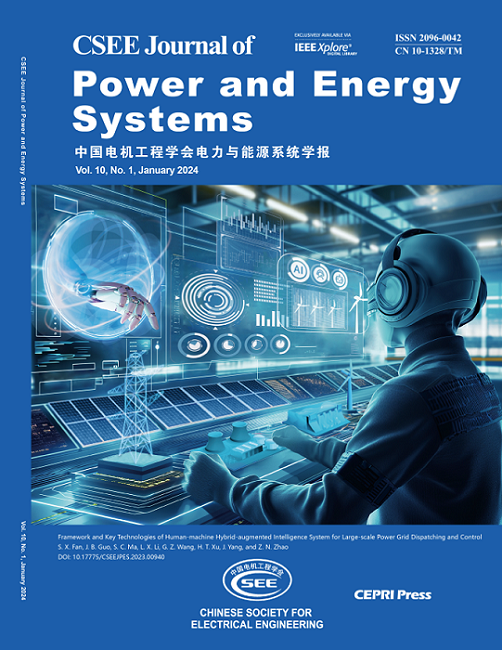超导电动飞机推进器直流故障中断特性的仿真分析
IF 6.9
2区 工程技术
Q2 ENERGY & FUELS
引用次数: 0
摘要
随着航空交通量的增加,与航空业相关的环境问题日益受到关注。对下一代飞机的燃料消耗和污染排放规定了严格的标准。超导电力推进飞机(SEPA)被视为实现这一目标的有效途径。高温超导(HTS)设备被广泛应用于电力系统,以提供巨大的能量。电力通过直流配电网络分配给不同的负载。然而,在短路状态下会产生高于额定电流十倍以上的浪涌电流,这对系统非常有害。因此,采用适当的保护方案至关重要。本文讨论了一种结合了直流真空断路器(DC VCB)和电阻式超导限流器(RSFCL)的保护方案,适用于超导飞机应用。考虑到成本和损耗问题,辅助电容器由系统电压预充电,机械元件熄灭电弧。此外,与 RSFCL 结合使用,可充分改善断路环境。RSFCL 可限制故障电流,然后由 VCB 根据创建的人工零电流(ACZ)来断开该限制电流。预期额定功率为 8MW,额定电压和电流分别为 4 kV 和 1 kA。本文讨论并模拟了保护 SEPA 的开关设备。在输电线路发生直流短路故障时,分析了断路器的分断性能。最后,计算了不同情况下的剩余能耗。比较了使用 RSFCL 和金属氧化物变阻器(MOV)与只使用 MOV 的情况。使用 RSFCL 的方案在能耗方面具有明显优势。本文章由计算机程序翻译,如有差异,请以英文原文为准。
Simulation Analysis of DC Fault Interruption Characteristics of Superconducting Electric Aircraft Propulsion
Environmental issues associated with the aviation industry are getting more attention as air traffic increases. Stringent standards are imposed for fuel consumption and pollution emissions for next-generation aircraft. Superconducting electrical propulsion aircraft (SEPA) have been seen as an efficient way to achieve this goal. High-temperature superconducting (HTS) devices are extensively used in the power system to supply enormous energy. Power is distributed to the different loads via a DC distribution network. However, it will generate an inrush current over ten times higher than the rated current in short-circuit state, which is very harmful to the system. Therefore, it is essential to adopt an appropriate protection scheme. This paper discusses one protection scheme that combines DC vacuum circuit breakers (DC VCB) and resistive superconducting current limiters (RSFCL) for superconducting aircraft applications. Considering problems of cost and loss, the auxiliary capacitor is pre-charged by system voltage, and mechanical elements extinguish the arc. Furthermore, combined with RSFCL, the interrupting environment is fully improved. RSFCL limits fault current, and then the VCB breaks this limited current based on creating an artificial current zero (ACZ). The prospective rated power is 8MW, rated voltage and current are 4 kV and 1 kA, respectively. In this paper, we discuss and simulate switching devices that protect SEPA. The interrupting performance of the circuit breaker is analysed in the DC short-circuit fault that occurs on the transmission line. Finally, the residual energy consumption of different situations is calculated. A comparison is made between using RSFCL with metal oxide varistor (MOV) and just using MOV. The scheme with RSFCL shows a significant advantage in energy consumption.
求助全文
通过发布文献求助,成功后即可免费获取论文全文。
去求助
来源期刊

CSEE Journal of Power and Energy Systems
Energy-Energy (all)
CiteScore
11.80
自引率
12.70%
发文量
389
审稿时长
26 weeks
期刊介绍:
The CSEE Journal of Power and Energy Systems (JPES) is an international bimonthly journal published by the Chinese Society for Electrical Engineering (CSEE) in collaboration with CEPRI (China Electric Power Research Institute) and IEEE (The Institute of Electrical and Electronics Engineers) Inc. Indexed by SCI, Scopus, INSPEC, CSAD (Chinese Science Abstracts Database), DOAJ, and ProQuest, it serves as a platform for reporting cutting-edge theories, methods, technologies, and applications shaping the development of power systems in energy transition. The journal offers authors an international platform to enhance the reach and impact of their contributions.
 求助内容:
求助内容: 应助结果提醒方式:
应助结果提醒方式:


